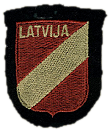A10 305 336
9421). One of the witnesses testified that prior to seeing the photographs he was told that he was going to see photos of men who participated in the extermination of Jewish people in Latvia and that since he had been in the Riga ghetto, maybe he would identify some of them. The same witness was the only one identifying the respondent's photograph wearing civilian clothing. Prior to this identification he was told that the set of photographs contained a photograph of the man he had previously identified wearing different clothing. Another witness testified that the last time she saw the set of photographs, the respective names were written underneath each photograph. Both witnesses' testimony indicate suggestiveness in the identification procedure and detract from the weight to be given to their identification of the respondent. Suggestiveness is also indicated by the fact that the only Service witness who described the military ranking of "Hazners" in 1941, described the four cubes, major's rank, which matched the photograph, instead of the three cubes, captain's rank, which the respondent held until 1944.2
We will assume, for purposes of this appeal, that the witnesses introduced by the Service identified a photograph of the respondent as the man whom they believed they saw 35 years earlier engaging in atrocities against Jewish people in Latvia. Therefore, it is not necessary to reach the issues of admissibility based on the best evidence rule on the facts in this case. Similarly, we will also consider as being in the record the respondent's visa photograph which was excluded by the immigration judge. The photograph was clearly reasonable, substantial and probative evidence under section 242(b)(4) of the Act, 8 U.S.C. 1252(b)(4) and was therefore admissible. Again, we do not find that photograph to be of as crucial importance as the Service contends. It adds no weight to the evidence once we assume that it was the respondent's photograph which was shown to the witnesses.3
EVALUATION OF THE WITNESSES' TESTIMONY
Evaluating the witnesses in a case of this nature is inherently difficult. Nearly 40 years have elapsed since the events transpired. Moreover, few events are more emotionally charged than the events during the Second World War and the persecution and atrocities committed upon the Jewish people and other ethnic groups in Europe by the Nazis. We will not disregard the respondent's witnesses' testimony as the Service suggests (Brief pg. 37-384), merely because they were Latvian military officers and therefore their testimony was self serving. Similarly, we
23
| 1 | Testimony of Maria Radiwker, 7-March-1978, cross examination, transcript pp. 865–955. |
| 2 | The photograph of Hāzners featured in the various Soviet propaganda publications show his rank as major. |
| 3 | Yet Hāzners's visa photograph was one of the two documents the OSI submitted in its motion to appeal the INS's loss, despite this review having considered it. |
| 4 | viz. our numbering, DOJ Brief page 36 |
